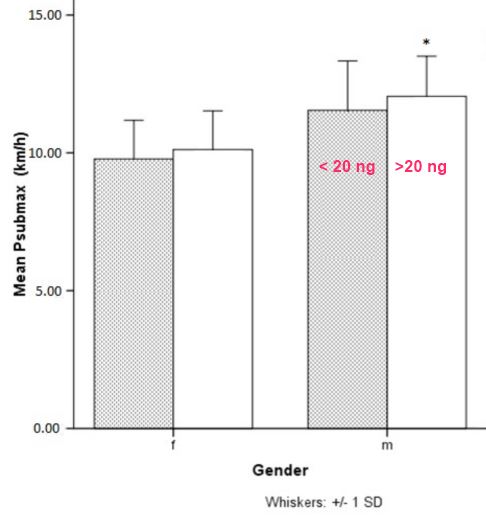Recreational athletes having more than 20 ng of vitamin D run faster
Association Between the 25-Hydroxyvitamin D Status and Physical Performance in Healthy Recreational Athletes.
Int J Environ Res Public Health. 2018 Dec 3;15(12). pii: E2724. doi: 10.3390/ijerph15122724.
Zeitler C1, Fritz R2, Smekal G3, Ekmekcioglu C4.
📄 Download the PDF from VitaminDWiki

Molecular and clinical studies have linked vitamin D (vitD) deficiency to several aspects of muscle performance. For this retrospective cross-sectional study data from 297 male (M) and 284 female (F) healthy recreational athletes were used to evaluate the prevalence of vitD deficiency in athletes living in Austria and to determine whether serum 25-hydroxyvitamin D (25(OH)D) correlates with maximal (Pmax) and submaximal physical performance (Psubmax) measured on a treadmill ergometer. The data were controlled for age, season, weekly training hours (WTH), body mass index (BMI) and smoking status. 96 M and 75 F had 25(OH)D levels ≤ 20 ng/mL. 25(OH)D levels showed seasonal variations, but no seasonal differences in Pmax and Psubmax were detected. M with 25(OH)D levels ≤ 20 ng/mL had significantly lower Psubmax (p = 0.045) than those with normal levels. In F no significant differences in Pmax or Psubmax were detected. Stepwise multiple regression analysis including all covariates revealed significant correlations between 25(OH)D levels and Pmax (β = 0.138, p = 0.003) and Psubmax (β = 0.152, p = 0.002) in M. Interestingly, for F significant correlations between 25(OH)D and both Pmax and Psubmax disappeared after adding WTH to the model. In conclusion, our data suggest that 25(OH)D status is associated with physical performance especially in M, while in F, WTH and BMI seem to affect the correlation.
